Editor’s Note: This week we’re reporting on the virtual programming related to the canceled 239th AAS Meeting. Along with a team of authors from Astrobites, we will be writing updates on selected events at the meeting and posting each day. Follow along here or at astrobites.com. The usual posting schedule for AAS Nova will resume on January 18.
Welcome to the Astrobites coverage of virtual events based around the canceled American Astronomical Society (AAS) meeting! We will report on highlights from each day here, from AAS Press Conferences to grassroots astronomy community meet-ups. If you’d like to see more timely updates during the day, we encourage you to search the #aas239 hashtag on twitter. We’ll be posting once a day during the week, so be sure the visit the site often to catch all the news!
Press Conference: Exoplanets & Their Atmospheres (by Lili Alderson)
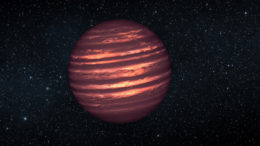
This artist’s rendering of a brown dwarf shows bands of clouds in its atmosphere. [NASA/ESA/JPL]
Thursday morning’s press conference focused on brown dwarfs, exoplanets, and their atmospheres. Kicking off the session was
Johanna Vos (American Museum of Natural History), who discussed recent work on the
weather of young brown dwarfs. Brown dwarfs, which are often called “failed stars,” aren’t massive enough to burn hydrogen, but have similar masses, temperatures, and compositions to large exoplanets. Young brown dwarfs are often very similar to directly imaged exoplanets, and so make great analogs. Using over 590 hours of
Spitzer Space Telescope observations, Johanna and collaborators watched brown dwarfs rotate to look for variations in their brightness indicative of the presence of clouds like Jupiter’s
Great Red Spot that reflect or absorb light. They found that younger brown dwarfs were more likely to show variations than older brown dwarfs, and that the variations were more extreme, possibly due to the fact that brown dwarfs become more compact as they get older, changing the atmosphere. These observations will help improve models of the atmospheres of directly imaged planets, which will be important when JWST observes these planets.
Press Release
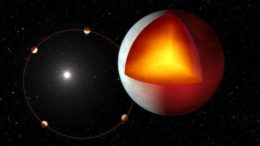
Artists’s impression of the internal heating of XO-3b, along with its elliptical orbit. [NASA/JPL-Caltech/R. Hurt (IPAC)]
Next, graduate student
Lisa Dang (McGill University) presented results from a study of XO-3b, a hot Jupiter exoplanet in an
eccentric orbit, which is in the process of migrating towards a more circular one! The eccentric orbit means XO-3b has very strong seasonal variations, with its “winter” lasting twice as long as its “summer.” Using
Spitzer to observe the planet as it traveled around its star, Lisa and her team measured XO-3b’s
phase curve, which allows the wind speeds and temperature variations to be studied throughout the seasons. The team found that XO-3b has excess heat that cannot be explained by seasonal changes alone, and, using Gaia data, found that the planet was puffier than expected. Both of these findings indicate that the planet is experiencing internal heating, which could be due to
tidal heating from the forces the XO-3b experiences as it migrates to a circular orbit.
NASA JPL Press Release |
McGill U. Press Release |
U. Montreal Press Release
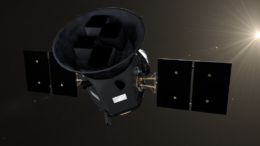
With the Transiting Exoplanet Survey Satellite (TESS), we can explore not only distant planetary systems, but also our own. [NASA’s Goddard Space Flight Center/CI Lab]
Up next with the discovery of three new exoplanets was
Samuel Grunblatt (American Museum of Natural History and the Flatiron Institute). All of the Transiting Exoplanet Survey Satellite (
TESS) planets in this presentation are orbiting evolved stars (those which have moved away from the
main sequence and are giants or sub-giants) and, given their short orbits, are some of the hottest planets known to exist around evolved stars! The first planet, TOI-2669b, could potentially be in an eccentric orbit, which would be unusual for its short period, while the second, TOI-2337b, has an extremely high density and will likely be
consumed by its host star sooner than any other known planet. Perhaps the most interesting, TOI-4329b, is the best planet orbiting an evolved star for atmospheric characterization, and it would be a great target for
JWST to help understand how exoplanets can end up in orbits like these.
Keck Observatory Press Release |
U. Hawaiʻi Press Release
Graduate student
Yoni Brande (University of Kansas) then presented the tentative detection of water vapor in the atmosphere of a super-Neptune exoplanet, TOI-674b. With a mass 23x that of Earth and an orbital period of less than 2 days, TOI-674b lies in the
Neptune Desert, making it one of few known Neptunian planets orbiting close to their stars. Yoni and collaborators made use of
Hubble’s Wide Field Camera 3 to look at the planet as it transited its star in the infrared and search for wavelength-dependent changes in the planet’s apparent size caused by its atmosphere. They found that the
atmospheric transmission spectrum can be best explained by the presence of water vapor, making TOI-674b one of a very small number of Neptune-like planets to have evidence of water!
Press Release
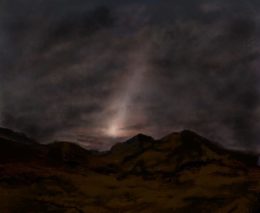
An artist’s impression of the detected zodiacal light on Kepler-69c. [SHAO/Yue Xu]
Finally,
Jian Ge (Shanghai Astronomical Observatory) discussed the detection of
zodiacal dust in three
Kepler systems. Joined in the press conference by high school students and collaborators Amanda Hao and Justin Hou, Jian explained how his team wanted to look for light scattered by dust from asteroids and comets around systems with
potentially habitable exoplanets, like the solar system’s zodiacal dust cloud as seen from Earth. Using data from a host of all-sky surveys, they found an excess of infrared radiation around Kepler-69, Kepler-1229, and Kepler-395, all of which host planets in the habitable zone. They also found that the dust had temperatures around 400K, hotter than in the solar system, suggesting that the dust is likely located closer to the stars of these systems than in our own solar system.
Press Release
YouTube recording
Press Conference: Intriguing Stars & Citizen Discoveries (by Graham Doskoch)
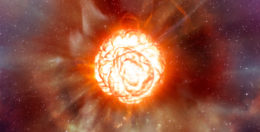
Artist’s impression of the roiling surface and strong stellar winds of Betelgeuse, a red supergiant star. [ESO/L. Calçada]
The final press conference of the week combined unconventional techniques with unusual objects. The first speaker was
Andrea Dupree (Center for Astrophysics | Harvard & Smithsonian), who summarized our understanding of
the Great Dimming exhibited by Betelgeuse between December 2019 and February 2020. The red supergiant interrupted its normal 400-day cycle of minor dimming and brightening by dropping roughly one
magnitude in optical light. Archival observations taken earlier in 2019 by the Hubble Space Telescope, coupled with later measurements, indicate that this was the result of a large mass ejection and dramatic outflow in the star’s atmosphere. The resulting dust scattered and absorbed Betelgeuse’s light, making it appear dimmer. It’s quite possible that Betelgeuse and other massive stars near the end of their lives have previously undergone similar episodes.
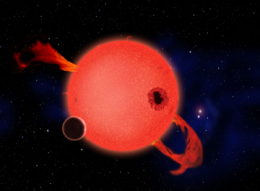
A flare erupts from a young red dwarf star in this artist’s illustration. [David A. Aguilar (CfA)]
The next presentation pivoted from one of the brightest stars in the sky to some of the dimmest: red dwarfs.
Scott Engle (Villanova University) presented the results of a long study of M-type dwarf stars aimed at improving our understanding of their evolution and characteristics. Since red dwarfs are dim and age slowly, this has historically been a challenge — and an important problem for astronomers testing evolutionary codes. Using years of data on red dwarfs in binary systems from the 1.3-meter robotic telescope at
Kitt Peak National Observatory, the team found that the stars fell into two groups: the more massive “early” red dwarfs of
spectral types M0 to M2, and the less massive “late” red dwarfs of spectral types M2.5 to M6. The groups exhibited different starspot patterns and obeyed different sets of changes in X-ray and ultraviolet activity with age.
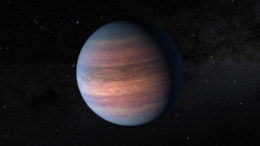
An artist’s impression of the Jovian exoplanet TOI-2180 b. This planet has the longest orbit of any planet discovered by the Transiting Exoplanet Survey Satellite (TESS) so far — and it’s a “cool” 170℉. [NASA/JPL-Caltech/R. Hurt]
The second half of the session was dedicated to discoveries made or enabled by citizen astronomers.
Paul Dalba (University of California, Riverside) announced the detection of a Jupiter-mass giant planet, TIO-2180b, which has a wide orbit around a bright star. It was first discovered as a single, long
transit in data from
TESS by the Visual Survey Group, an organization of citizen scientists who search for exoplanet candidates that might be missed by algorithms. Follow-up observations by Dalba and colleagues using the
Lick Observatory provided more information on its properties. While a massive effort by the team and citizen astronomers at 14 sites over three continents was unable to detect the second predicted transit, they plan to try again in February when TIO-2180b is next expected to transit.
UC Riverside Press Release |
NASA Press Release |
U. New Mexico Press Release
Undergraduate
Emma Softich (Arizona State University) presented a truly unique find. Using data from NASA’s
Wide-field Infrared Survey Explorer (WISE) and working in conjunction with the Backyard Worlds citizen science program, she discovered a binary
brown dwarf with the largest known separation of its kind. CWISE J014611.20-050850.0AB consists of an L4-type brown dwarf 72 times the mass of Jupiter and an L8-type brown dwarf 66 times the mass of Jupiter, orbiting each other at around 129
astronomical units. Although the system is expected to stay bound for several billion years, it’s surprising that it survived efforts to tear it apart by neighboring stars near its birthplace. Lying only 135 light-years from Earth, CWISE J014611.20 raises an interesting question: how many systems like it are out there?
Press Release
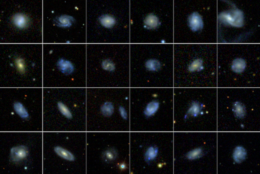
A selection of 24 star-forming galaxies analyzed by volunteers from the Galaxy Zoo: Clump Scout project. Some blue star-forming clumps are quite bright, while others are harder to detect. Click to enlarge. [Nico Adams]
The session concluded with a trip through cosmic time guided by graduate student
Nico Adams (University of Minnesota, Twin Cities). Adams presented the results of the Galaxy Zoo: Clump Scout project, which gathered information on blue “giant star-forming clumps” in galaxies in the modern universe. There are two proposed methods for their formation: the
in situ model, where turbulence within the galaxy governs their formation and evolution, and the
ex situ model, where they form externally via galaxy mergers. While these clumps have been studied in distant galaxies in the early universe, their properties later on were not well-known. High-redshift galaxies show “clumpy fractions” — the fraction of galaxies with clumps — around 60%. The Galaxy Zoo: Clump Scout project enlisted volunteers to identify clumps in tens of thousands of modern-day galaxies and used the resulting 7,000 clumps in 10,000 of those galaxies to find that the modern-day clumpy fraction is only 2-3%. This provides evidence that clumps form
in situ, from clouds of gas within a galaxy, since turbulence has gone down throughout cosmic time but merger rates have stayed flatter. If the
ex situ model was correct, merger rates would have needed to drop to explain the relative lack of clumps in the local universe.
Press Release
Live-tweeting by Graham Doskoch
YouTube recording
CHAMPs Early Career Researcher Highlight Seminar (by Macy Huston)
When the AAS 239 meeting was canceled, many were disappointed to lose the opportunity to present their research. Immediately, astronomers began planning events to try to fill that void. Not long after, the CHAMPs (Consortium on Habitability and Atmospheres of M-dwarf Planets) collaboration announced their Exoplanet Early Career Highlight Seminar, a two-day event where those with canceled talks could gather and discuss their work.
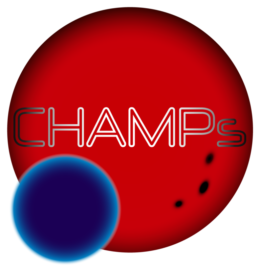 Dr. Erin May, the postdoc who leads the organization of the new CHAMPs seminar series, emphasized the importance of focusing on early career researchers for whom conferences and networking are especially important. She tweeted, “While this can’t fully replicate the lost networking, we hope it takes some of the pain away.” The idea for this event had been in Erin and others’ minds before the AAS 239 cancellation as an alternative for those who didn’t feel comfortable making the trip in person. When COVID spiked and AAS 239 cancellation became a likely scenario, the planning process launched. Despite only having a couple weeks over the holidays to put it together, the organizers hit only a few technical snags along the way.
Dr. Erin May, the postdoc who leads the organization of the new CHAMPs seminar series, emphasized the importance of focusing on early career researchers for whom conferences and networking are especially important. She tweeted, “While this can’t fully replicate the lost networking, we hope it takes some of the pain away.” The idea for this event had been in Erin and others’ minds before the AAS 239 cancellation as an alternative for those who didn’t feel comfortable making the trip in person. When COVID spiked and AAS 239 cancellation became a likely scenario, the planning process launched. Despite only having a couple weeks over the holidays to put it together, the organizers hit only a few technical snags along the way.
Almost 60 abstracts were submitted for the seminar, and the organizers were able to accept 47, 10 of which were dissertation talks, where soon-to-be PhD recipients were given a bit more time to present a fuller story of their work. Three of these non-dissertation talks were from current Astrobites authors: Ali Crisp, Macy Huston, and Yoni Brande!
The event was held January 13-14, 2022 and consisted of four sessions:
- Transits, Radial Velocities, and Direct Imaging
- Interstellar Objects, Terrestrial Planets, Biosignatures and Habitability
- Atmospheres (Exoplanets and Brown Dwarfs)
- Disks, Planet Formation, and Star-Planet Interactions
Subsections of these sessions were each moderated by an early career researcher who spoke at the event. Recordings of Day 1 are available here, and Day 2’s will be posted on the same YouTube channel shortly.
In addition to the talks and Q&A sessions held on Zoom, a Slack workspace was created for the event for extending discussions and networking. The #random channel provided entertainment and social interaction during the event, primarily being devoted to pet photos, including some friendly competition between dog and cat people, as well as some unique pets like frogs, hedgehogs, and even donkeys!
Overall, over 200 astronomers registered for the event, and at the point of peak attendance, over 100 people were present! The organizers were thrilled with the positive response to the event and hopeful that speakers were able to reach even more people than they would have at in-person AAS 239.


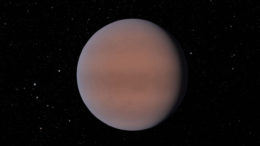




 Dr. Erin May, the postdoc who leads the organization of the new CHAMPs seminar series, emphasized the importance of focusing on early career researchers for whom conferences and networking are especially important. She tweeted, “While this can’t fully replicate the lost networking, we hope it takes some of the pain away.” The idea for this event had been in Erin and others’ minds before the AAS 239 cancellation as an alternative for those who didn’t feel comfortable making the trip in person. When COVID spiked and AAS 239 cancellation became a likely scenario, the planning process launched. Despite only having a couple weeks over the holidays to put it together, the organizers hit only a few technical snags along the way.
Dr. Erin May, the postdoc who leads the organization of the new CHAMPs seminar series, emphasized the importance of focusing on early career researchers for whom conferences and networking are especially important. She tweeted, “While this can’t fully replicate the lost networking, we hope it takes some of the pain away.” The idea for this event had been in Erin and others’ minds before the AAS 239 cancellation as an alternative for those who didn’t feel comfortable making the trip in person. When COVID spiked and AAS 239 cancellation became a likely scenario, the planning process launched. Despite only having a couple weeks over the holidays to put it together, the organizers hit only a few technical snags along the way.



